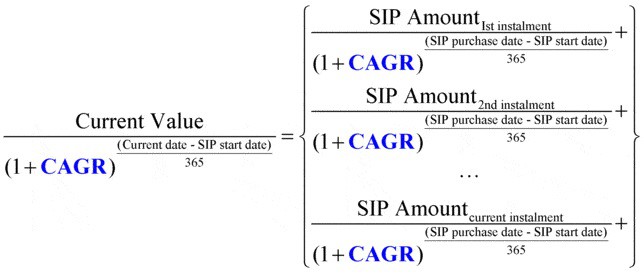Last Updated on December 29, 2021 at 5:15 pm
A few months back we saw what a compounded annual growth rate (CAGR) is and how it is calculated in the case of a lump sum investment.
In this post, let us consider a mutual fund SIP and calculate the associated return.
First a quick recap.
Lump sum investment: Non-volatile instruments
When a lump sum is invested in a non-volatile instrument like a fixed deposit, the maturity value is clearly known even before the investment starts. This is because there is well defined compounding – quarterly in most cases.
Join 32,000+ readers and get free money management solutions delivered to your inbox! Subscribe to get posts via email! (Link takes you to our email sign-up form)
🔥Want to create a complete financial plan? Learn goal-based investing? Exclusive access to our DIY tools? Increase your income with your skills? Use this link to enjoy massive discounts on our robo-advisory tool & courses! 🔥
So the CAGR is a well defined number. For quarterly compounding, it is simply the effective annualized rate.
Check out the comprehensive fixed deposit calculators available @ freefincal
Lump sum investment: Volatile Instruments
When the lump sum is invested in volatile investments like gold, real estate or stocks, the maturity value can be just about anything – a 100% more or 100% less!
So the CAGR can be calculated only when the current value is known (in contrast for a fixed deposit, the current value can be calculated with the CAGR).
For volatile instruments there is no compounding! There is only appreciation or depreciation of the underlying asset (stock, bond, commodity, real estate etc.)
We calculate CAGR by pretending the instrument compounds at a rate r
r = CAGR =(maturity value/investment)(1/years)-1
For more details on how this is related to annual returns, see here.
Recurring investment: Non-volatile instruments
The recurring deposit is an example of periodic investments in a non-volatile investment. It is nothing but a series of fixed deposits of reducing the tenure. For example, if you open an RD for 2 years, the 1st instalment is an FD of 24 months duration. The second instalment is an FD of 23 months duration and so on.
Therefore, here again the maturity value is known before the investment begins.
Check out the comprehensive recurring deposit calculators available @ freefincal
Recurring investment: Volatile Instruments
The monthly SIP is a classic example of this category. There are several ways to calculate the associated return. A couple of them can be found here: Mutual Fund SIP Returns Calculator
Before we understand how to calculate returns from a volatile instrument like a mutual fund SIP, I request you to stare at this spaghetti making machine for a few moments.
Photo Credit: cefeida (Flickr)
Now let us ‘draw’ some analogies
Investing in non-volatile instruments
Lump sum investments: A single spaghetti strand of known length
Recurring investments: Multiple spaghetti strands of known but different lengths
In both cases, since the lengths are known, there is nothing to calculate.
Investing in volatile instruments
Lump sum investment: A single spaghetti strand of unknown length
If I give you the strand, you can easily DETERMINE the length. No big deal.
Recurring investment: Multiple spaghetti strands of unknown length
Now, how will you go about determining the average length of the strands?
Here is another picture to drive home my point. Excuse my indulgence. I simply love spaghetti!
Photo Credit: renekyllingstad (Flickr)
Since it is not practical to measure the length of each strand and average it, you ESTIMATE the average length.
Similarly,
- for lump sum investments in volatile instruments, you can DETERMINE the CAGR if you know the current value of the investment. The answer in this case is exact (assuming there is compounding involved).
- for recurring investments in volatile instruments, you can only ESTIMATE the CAGR if you know the current value of the investment. The answer in this case is approximate (again assuming there is compounding involved).
Why the spaghetti analogy? Why estimate?
The reason will become clear when we realise that some SIP instalments may occur during market lows and some during market highs. So each instalment will have different current value depending on the date of purchase.
For example, when direct mutual fund plans were introduced, the value of my monthly investments in HDFC Top 200 regular plan was green (positive) while the value of monthly investments in the direct plan was red (negative) for a long time.
That is each instalment grows at an entirely different pace. Hence, the analogy with spaghetti strands of different and unknown lengths.
We will need to estimate CAGR because the investments were made at different points in time and we always look at the total value of all the instalments.
Don’t worry too much about the math that follows, it would suffice if you could appreciate the difference between determining CAGR for lump sum investments and estimating CAGR for SIP investments.
The CAGR for SIP investments is estimated by an iterative technique called Newton Raphson method. Excel implements this via an extraordinarily simple function known as XIRR.
Investors who have online accounts in portals like ICICI AMC, FundsIndia, Value Research and software packages like MProfit must be familiar with the use of XIRR for SIP investments. Xirr is also used in my mutual fund tracker.
Here is the formula (take a deep breath!)

Try to pull the CAGR to one side. That is, try writing this equation as
CAGR = (rest of the quantities)!
Well, you cannot. It is impossible. Therefore, the CAGR is estimated.
To estimate something, you need an approximation technique. There are several available. Each of them will have its own limitation!
If the current value is much lower than the total investment, that is if we suffer a loss and if it is a heavy one, XIRR usually gives an error.
This means the CAGR cannot be estimated or there are multiple solutions to the given problem!!
More about XIRR
- IRR/XIRR – Excel – Limitations of Calculating Complex Cash Flow Returns
- Excel IRR and XIRR: Spot bugs and understand errors with this cash flow returns analyser
Resources
Note
Sometimes people assume SIP installments are spaced 30 days apart, ignoring both the actual number of days in a month and number of business days. This is done using Excel functions IRR and RATE. See this Excel sheet. While it is one thing to assume investments are spaced 30 days apart while planning for a financial goal, it is quite another to make that assumption for ongoing SIPs. One must always use the XIRR function for ongoing SIPs.

Use our Robo-advisory Tool to create a complete financial plan! ⇐More than 3,000 investors and advisors use this! Use the discount code: robo25 for a 20% discount. Plan your retirement (early, normal, before, and after), as well as non-recurring financial goals (such as child education) and recurring financial goals (like holidays and appliance purchases). The tool would help anyone aged 18 to 80 plan for their retirement, as well as six other non-recurring financial goals and four recurring financial goals, with a detailed cash flow summary.
🔥You can also avail massive discounts on our courses and the freefincal investor circle! 🔥& join our community of 8000+ users!
Track your mutual funds and stock investments with this Google Sheet!
We also publish monthly equity mutual funds, debt and hybrid mutual funds, index funds, and ETF screeners, as well as momentum and low-volatility stock screeners.
You can follow our articles on Google News

We have over 1,000 videos on YouTube!

Join our WhatsApp Channel



- Do you have a comment about the above article? Reach out to us on Twitter: @freefincal or @pattufreefincal
- Have a question? Subscribe to our newsletter using the form below.
- Hit 'reply' to any email from us! We do not offer personalised investment advice. We can write a detailed article without mentioning your name if you have a generic question.
Join 32,000+ readers and get free money management solutions delivered to your inbox! Subscribe to get posts via email! (Link takes you to our email sign-up form)
About The Author
 Dr M. Pattabiraman (PhD) is the founder, managing editor and primary author of freefincal. He is an associate professor at the Indian Institute of Technology, Madras. He has over 13 years of experience publishing news analysis, research and financial product development. Connect with him via Twitter(X), LinkedIn, or YouTube. Pattabiraman has co-authored three print books: (1) You can be rich too with goal-based investing (CNBC TV18) for DIY investors. (2) Gamechanger for young earners. (3) Chinchu Gets a Superpower! for kids. He has also written seven other free e-books on various money management topics. He is a patron and co-founder of “Fee-only India,” an organisation promoting unbiased, commission-free, AUM-independent investment advice.
Dr M. Pattabiraman (PhD) is the founder, managing editor and primary author of freefincal. He is an associate professor at the Indian Institute of Technology, Madras. He has over 13 years of experience publishing news analysis, research and financial product development. Connect with him via Twitter(X), LinkedIn, or YouTube. Pattabiraman has co-authored three print books: (1) You can be rich too with goal-based investing (CNBC TV18) for DIY investors. (2) Gamechanger for young earners. (3) Chinchu Gets a Superpower! for kids. He has also written seven other free e-books on various money management topics. He is a patron and co-founder of “Fee-only India,” an organisation promoting unbiased, commission-free, AUM-independent investment advice.Our flagship course! Learn to manage your portfolio like a pro to achieve your goals regardless of market conditions! ⇐ More than 3,500 investors and advisors are part of our exclusive community! Get clarity on how to plan for your goals and achieve the necessary corpus no matter the market condition!! Watch the first lecture for free! One-time payment! No recurring fees! Life-long access to videos! Reduce fear, uncertainty and doubt while investing! Learn how to plan for your goals before and after retirement with confidence.
Increase your income by getting people to pay for your skills! ⇐ More than 800 salaried employees, entrepreneurs and financial advisors are part of our exclusive community! Learn how to get people to pay for your skills! Whether you are a professional or small business owner seeking more clients through online visibility, or a salaried individual looking for a side income or passive income, we will show you how to achieve this by showcasing your skills and building a community that trusts and pays you. (watch 1st lecture for free). One-time payment! No recurring fees! Life-long access to videos!
Our book for kids: “Chinchu Gets a Superpower!” is now available!


Must-read book even for adults! This is something that every parent should teach their kids right from their young age. The importance of money management and decision making based on their wants and needs. Very nicely written in simple terms. - Arun.Buy the book: Chinchu gets a superpower for your child!
How to profit from content writing: Our new ebook is for those interested in getting a side income via content writing. It is available at a 50% discount for Rs. 500 only!
Do you want to check if the market is overvalued or undervalued? Use our market valuation tool (it will work with any index!), or get the Tactical Buy/Sell timing tool!
We publish monthly mutual fund screeners and momentum, low-volatility stock screeners.
About freefincal & its content policy. Freefincal is a News Media organisation dedicated to providing original analysis, reports, reviews and insights on mutual funds, stocks, investing, retirement and personal finance developments. We do so without conflict of interest and bias. Follow us on Google News. Freefincal serves more than three million readers a year (5 million page views) with articles based only on factual information and detailed analysis by its authors. All statements made will be verified with credible and knowledgeable sources before publication. Freefincal does not publish paid articles, promotions, PR, satire or opinions without data. All opinions will be inferences backed by verifiable, reproducible evidence/data. Contact Information: To get in touch, please use our contact form. (Sponsored posts or paid collaborations will not be entertained.)
Connect with us on social media
- Twitter @freefincal
- Subscribe to our YouTube Videos
- Posts feed via Feedburner.
Our publications
You Can Be Rich Too with Goal-Based Investing
 Published by CNBC TV18, this book is designed to help you ask the right questions and find the correct answers. Additionally, it comes with nine online calculators, allowing you to create custom solutions tailored to your lifestyle. Get it now.
Published by CNBC TV18, this book is designed to help you ask the right questions and find the correct answers. Additionally, it comes with nine online calculators, allowing you to create custom solutions tailored to your lifestyle. Get it now.Gamechanger: Forget Startups, Join Corporate & Still Live the Rich Life You Want
 This book is designed for young earners to get their basics right from the start! It will also help you travel to exotic places at a low cost! Get it or gift it to a young earner.
This book is designed for young earners to get their basics right from the start! It will also help you travel to exotic places at a low cost! Get it or gift it to a young earner.Your Ultimate Guide to Travel
 This is an in-depth exploration of vacation planning, including finding affordable flights, budget accommodations, and practical travel tips. It also examines the benefits of travelling slowly, both financially and psychologically, with links to relevant web pages and guidance at every step. Get the PDF for Rs 300 (instant download)
This is an in-depth exploration of vacation planning, including finding affordable flights, budget accommodations, and practical travel tips. It also examines the benefits of travelling slowly, both financially and psychologically, with links to relevant web pages and guidance at every step. Get the PDF for Rs 300 (instant download)
